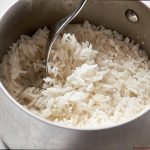Hey there, fellow steak aficionados. Are you tired of struggling to achieve that perfect sear on your steak? Do you find yourself wondering whether or not to use oil in the skillet while searing? Well, fear not. We’re here to settle this debate once and for all.
Some folks argue that using oil can interfere with getting that coveted crust, while others swear by it to prevent their steak from sticking. So, what’s the verdict? Should you put oil in the skillet when searing steak?
In this blog post, we’ll dive deep into the science behind searing and explore whether or not adding oil to your skillet can make a difference. We’ll also discuss which types of oils work best and how they affect the flavor of your meat.
Whether you’re a seasoned pro or just starting out in the kitchen, our goal is to arm you with all the knowledge you need to create mouth-watering, restaurant-quality steaks every time. So why wait? Let’s get cooking. Read on to discover everything you need to know about using oil in your skillet when searing steak.
Contents
What is Seared Steak?
Look no further than seared steak, a mouth-watering cooking technique that involves quickly cooking the steak at high heat to create a crispy crust on the outside while keeping the inside juicy and tender. Let’s dive into what makes seared steak so special.
The first step in this cooking technique is heating a skillet or grill pan to high heat. While some argue against using oil, others believe it can help the steak cook more evenly and prevent it from sticking. If you’re using a nonstick skillet, you may not need any oil at all, but for stainless steel or cast iron, a high smoke point oil such as vegetable, canola, or grapeseed can be added to prevent sticking and enhance flavor.
Once your skillet is heated and oiled, it’s time to start cooking your steak. The key to a perfect sear is high heat and a well-seasoned skillet or grill pan. Thicker steaks may benefit from a little bit of oil to help distribute heat more evenly. Adding butter or herbs to the oil can also enhance the flavor of the steak.
A properly seared steak should have a charred crust on the outside while still being pink and juicy on the inside. To achieve this, cook the steak for a short period of time on each side, then allow it to rest after cooking. This ensures maximum juiciness and flavor.
The Debate: Should You Use Oil or Not?
When it comes to searing a steak, sparks fly over whether or not to use oil. Some argue that oil can interfere with the Maillard reaction, responsible for producing the delicious crust on the surface of the steak, while others believe that oil is necessary to prevent the steak from sticking to the pan and to help distribute heat evenly.
Proponents of using oil argue that it can help create a more even, consistent sear on the steak. By coating the surface of the steak with a thin layer of oil, you can ensure even contact with the hot skillet surface. This leads to more even browning and an overall better sear.
On the other hand, opponents of using oil suggest that it can inhibit the Maillard reaction. This reaction occurs when amino acids and sugars in the meat react with heat, producing a complex series of chemical reactions that result in that delicious crust on the surface of the steak. Adding oil to the pan may create a barrier between the meat and heat source, preventing this reaction from happening.
The verdict? It ultimately comes down to personal preference and circumstance. If you’re using a well-seasoned skillet or grill pan and cooking for a short period on each side before allowing it to rest, then skipping oil may be a good choice. However, if you’re worried about sticking or uneven heating, a little bit of oil can make a big difference.
If you do choose to use oil, make sure to choose an option with a high smoke point like avocado oil, grapeseed oil, or refined coconut oil. This ensures that your steak isn’t negatively impacted by burnt or smoking oil.
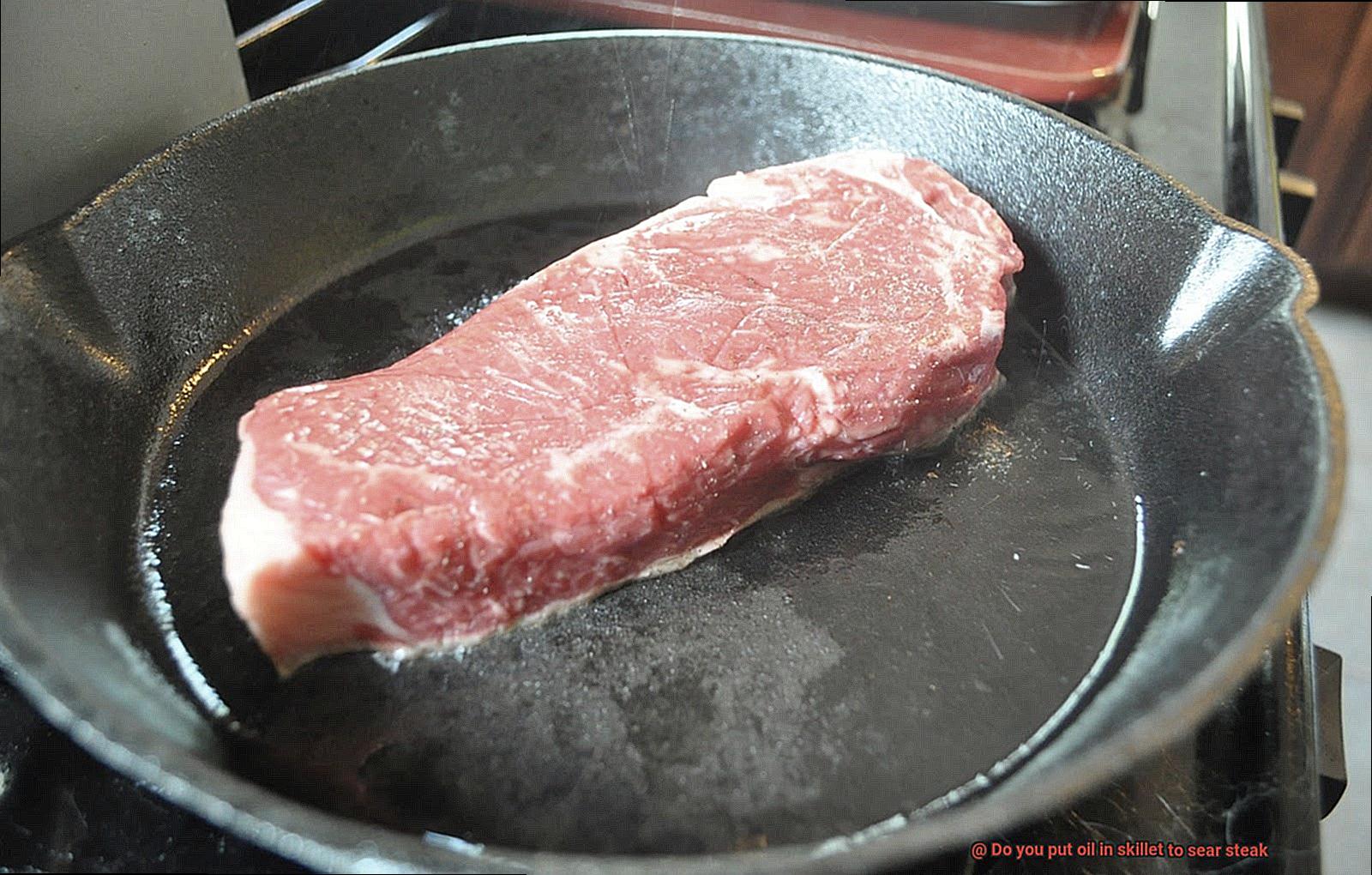
In general, remember that whether or not to use oil is just one piece of the larger puzzle. The real magic happens with a well-seasoned skillet, a hot heat source, and perfect timing. To achieve that perfect sear, consider these additional tips:
- Preheat your skillet or grill pan before adding the steak.
- Let the steak come to room temperature before searing.
- Don’t crowd the pan with too many steaks at once.
- Don’t flip the steak too often – let it sear for a few minutes on each side before turning.
- Allow the steak to rest for a few minutes before slicing.
Types of Skillets to Consider
To achieve the perfect sear on your steak, it’s essential to choose the right skillet. There are several types of skillets to consider, each with its own set of advantages and disadvantages. Let’s explore the various types of skillets and their pros and cons so that you can choose the perfect one for searing your steak.
Cast iron skillets are a popular choice among home cooks and chefs alike. They retain heat well and distribute it evenly, making them ideal for searing steak. Cast iron skillets also develop a natural non-stick surface over time, which makes them easy to clean. However, they are heavy and require seasoning before use, which can be intimidating for some.
Stainless steel skillets are another option for searing steak. They heat up quickly and evenly, but don’t retain heat as well as cast iron. Stainless steel skillets also don’t develop a non-stick surface, so you may need to add oil or butter to prevent sticking. The advantage of stainless steel is that it is easy to clean and does not require seasoning.
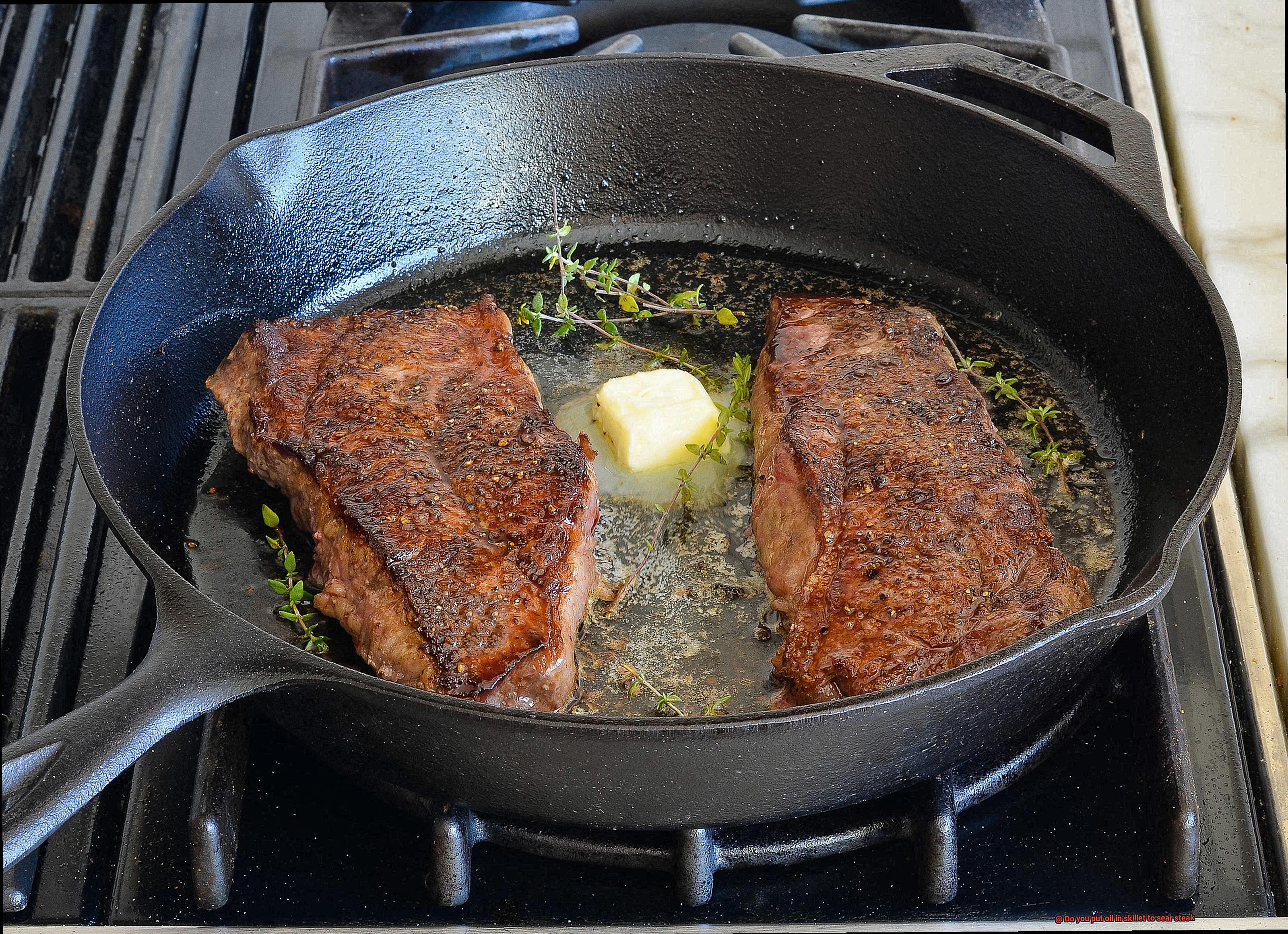
Carbon steel skillets are similar to cast iron in terms of their heat retention and distribution properties. However, they are lighter in weight and have a smoother surface, which can make them easier to use for some people. Carbon steel skillets also require seasoning before use, but once seasoned, they develop a natural non-stick surface that makes them easy to clean.
Non-stick skillets are an option if you prefer to use less oil or butter when searing steak. They are easy to clean and do not require seasoning. However, non-stick skillets do not retain heat as well as other types of skillets, which can result in uneven cooking.
In addition to these materials, you should also consider the size and shape of your skillet. A large skillet with a flat bottom is ideal for searing steak, as it allows the meat to cook evenly. A smaller skillet may work if you’re only cooking a small steak, but it may not distribute heat as well.
Factors to Consider When Deciding Whether to Use Oil
The answer is not straightforward, as several factors come into play when making this decision.
To begin with, the type of steak you’re cooking is a crucial consideration. If you’re working with a fatty cut like a ribeye or strip steak, you might not require any extra oil. The fat content in these cuts will render, creating its own cooking medium. However, if you’re cooking a leaner cut like filet mignon or flank steak, adding a small amount of oil can help prevent sticking and promote even browning.
The type of skillet you’re using is another important factor. Cast iron skillets are naturally non-stick and can often sear a steak without any additional oil. On the other hand, stainless steel or non-stick skillets may require some oil to prevent sticking.
Temperature is also crucial in determining whether to use oil. A hot skillet can sear a steak effectively without any additional oil, thanks to the high heat that creates a natural non-stick surface. However, if your skillet isn’t hot enough or the heat distribution is uneven, adding some oil can help promote even browning and prevent sticking.
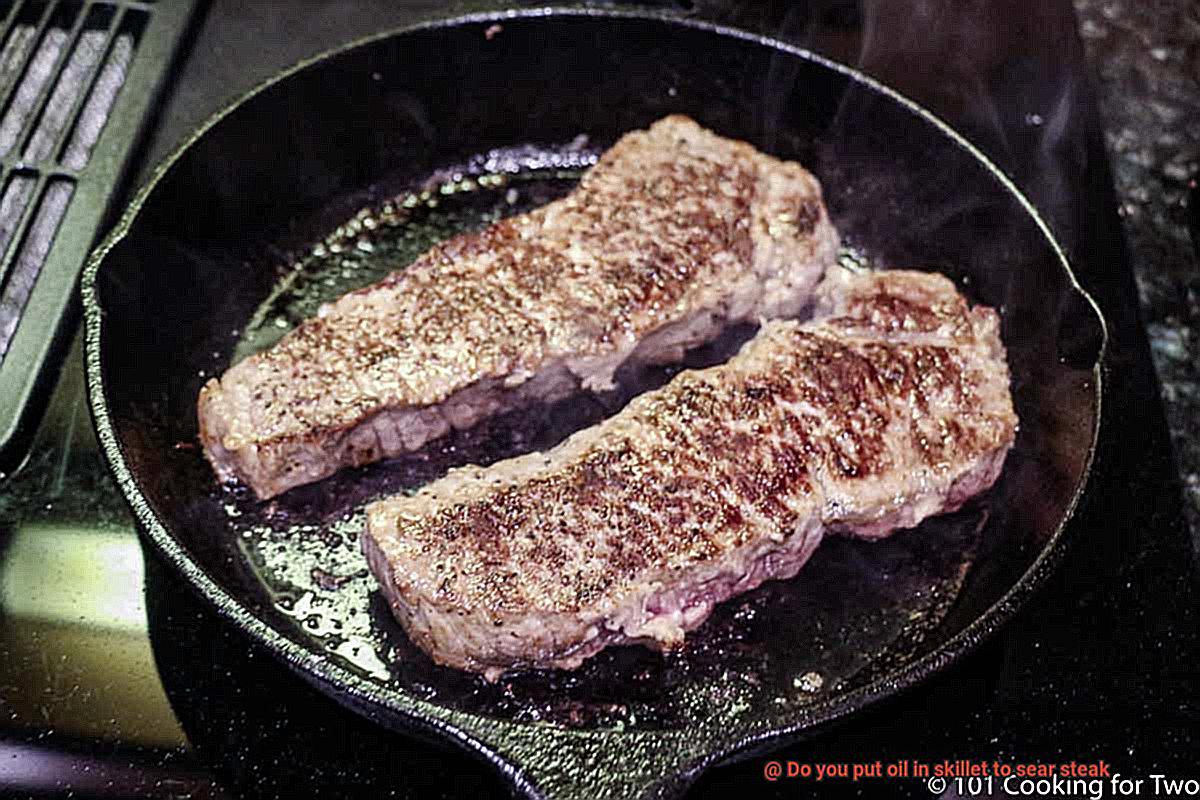
Finally, personal preference plays a role in deciding whether or not to use oil while searing your steak. Some chefs prefer the flavor and texture that oil adds to their seared steak, while others prefer the simplicity of a dry-seared approach.
Benefits of Using Oil in a Skillet for Searing Steak
Look no further than using oil in your skillet. As a seasoned expert in the world of cooking, I can tell you that using oil can provide a range of benefits when it comes to searing steak.
First and foremost, using oil ensures that your steak won’t stick to the skillet. It’s a common problem when cooking meat and can lead to an unpleasant, torn-apart steak. By using oil, you can ensure that your steak forms a delicious crust on the outside while remaining juicy and tender on the inside.
Additionally, using oil helps distribute heat evenly throughout the skillet. This ensures that your steak cooks evenly from top to bottom, without worrying about hot spots or uneven cooking. Oil heats up more quickly and evenly than the skillet itself, achieving a more consistent sear on your steak.
But that’s not all; using oil in your skillet can also add extra flavor to your steak. Different types of oils provide different flavor profiles, so choosing the right one can take your steak to the next level. Olive oil provides a rich, fruity flavor, while sesame oil adds a nutty, toasted taste. Experiment with different oils to find one that complements the natural taste of your steak.
It’s important to choose the right type of oil and use it in moderation. You don’t want to overpower the natural taste of your steak with too much oil or an oil that doesn’t complement its flavor. Some options for oils include avocado oil, grapeseed oil, and coconut oil. Each has its unique characteristics and flavors.
How to Choose the Right Type of Oil for Searing Steak
Searing steak is an art that requires the right type of oil to achieve the perfect crust and juicy interior. Here are some tips on how to choose the right oil for searing steak:
Consider the Smoke Point
The smoke point refers to the temperature at which an oil begins to break down and produce smoke. When searing steak, it’s important to choose an oil with a high smoke point to prevent a burnt flavor and harmful compounds. Avocado oil, grapeseed oil, and refined peanut oil are great options for high smoke points.
Flavor Matters
The flavor of the oil can impact the overall taste of your steak. If you want a neutral flavor that won’t overpower the taste of your steak, go for oils like canola or vegetable oil. On the other hand, if you want a more distinct flavor, olive oil can add richness and depth to your steak.
Opt for Healthy Fats
Healthy fats like mono-unsaturated fatty acids (MUFAs) and poly-unsaturated fatty acids (PUFAs) are better than saturated fats and can improve the texture of your steak. Oils like avocado and olive oil are high in MUFAs, while grapeseed and walnut oil contain more PUFAs.
Thickness of Your Steak
If you’re dealing with thicker cuts of steak, using a little bit of oil can help distribute heat more evenly and ensure a well-seared exterior.
Desired Flavor Profiles
If you’re looking for a smoky flavor in your steak, consider using ghee or clarified butter instead of regular butter as they have higher smoke points and can add nuttiness to your dish.
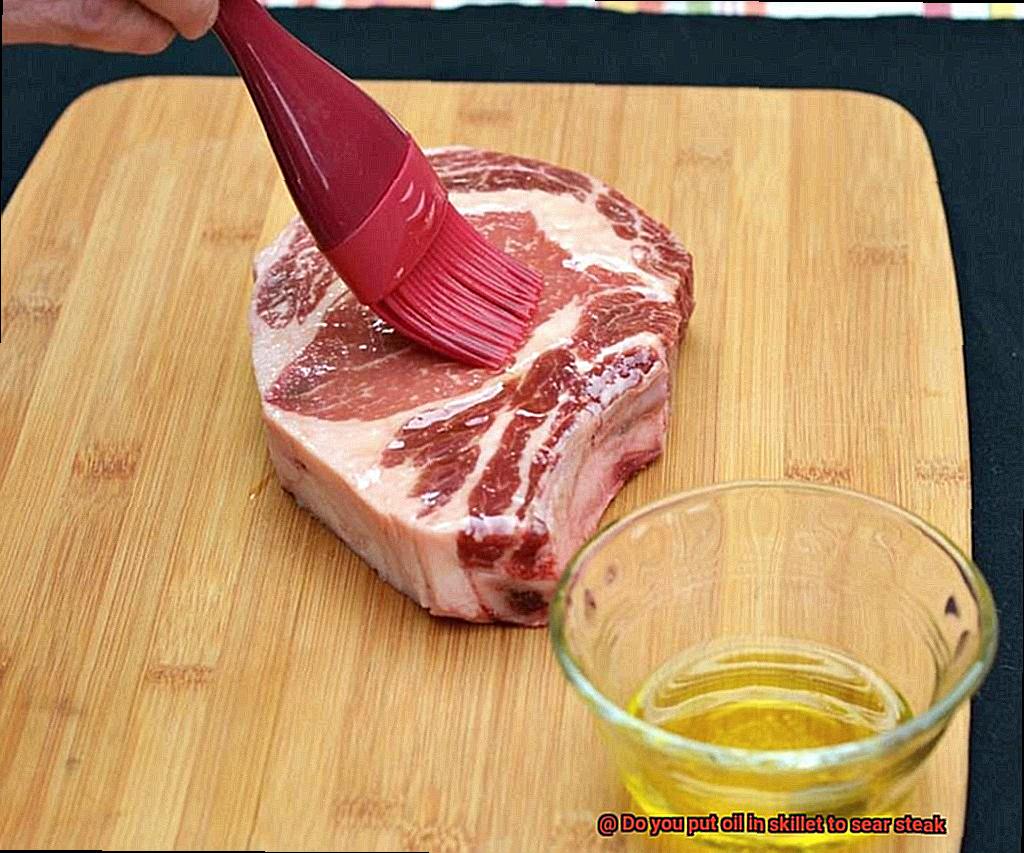
Skillet Type Matters
The type of skillet you use can also affect the choice of oil. Non-stick skillets don’t require any oil as they prevent sticking, while stainless steel or cast iron skillets may require higher smoke point oils like canola, vegetable, or grapeseed oil.
Tips for Getting the Perfect Sear on a Steak
How to Achieve the Perfect Sear on Your Steak
The perfect sear on a steak is the holy grail of steak cooking – that beautiful, caramelized crust on the outside and juicy, tender meat on the inside. To achieve this, there are several steps you need to follow.
Use the Right Oil
Using oil in your skillet is essential for creating a barrier between the meat and the hot surface of the skillet, preventing the meat from sticking and allowing for an even sear. However, not all oils are created equal. You want a high smoke point oil like canola, vegetable, or grapeseed oil. These oils can withstand high temperatures without smoking or burning, allowing you to get that perfect crust on your steak.
Preheat Your Skillet
Before adding any oil or steak to your skillet, make sure it’s hot enough to sear your steak properly. Preheat your skillet over high heat for at least 5 minutes before adding anything to it. You want your skillet to be almost smoking hot before adding your steak. This initial sear will help seal in the juices of the steak.
Don’t Use too Much Oil
While using oil is important for achieving a good sear, don’t use too much of it. A thin layer is all you need – just enough to coat the bottom of your skillet. Too much oil can actually hinder the searing process and prevent that perfect crust from forming.
Let Your Steak Cook Undisturbed
Once you’ve added your steak to the hot skillet, resist the urge to move it around or flip it too soon. Let it cook undisturbed for at least 2-3 minutes on each side before flipping. This will help ensure that a crust forms on the outside of the steak, locking in all those delicious juices.
Add Butter and Herbs for Extra Flavor
For an extra burst of flavor, consider adding some butter and herbs to your skillet after you’ve flipped your steak. As the butter melts and mixes with the meat juices, it creates a delicious sauce that will take your steak to the next level.
kVC9MAvnrOY” >
Conclusion
In the end, the age-old question of whether to use oil in a skillet when searing steak has been answered. The verdict? It’s entirely up to you and your specific situation. While some argue that oil can hinder the Maillard reaction responsible for producing that coveted crust on your steak, others swear by it to prevent sticking and promote even heat distribution.
If you do opt for oil, remember to choose one with a high smoke point like avocado oil, grapeseed oil, or refined coconut oil. Don’t forget that different oils also bring their unique flavor profiles to the table—experimentation is key.
Perfecting your sear game requires using a well-seasoned skillet or grill pan, preheating it before adding anything to it, letting your steak cook uninterrupted for at least 2-3 minutes per side before flipping, and giving it a few minutes’ rest before slicing. By keeping these tips in mind and accounting for factors such as skillet type and steak thickness, you’ll be able to whip up mouth-watering steaks just like those found in restaurants.






